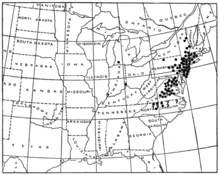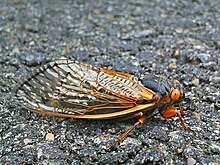Brood II
Brood II ( Brood 2 ) is a population of the "Periodic Cicadas" ( Magicicada ) in the northeastern United States . Every 17th year, Brood II cicadas burrow en masse to the surface, lay eggs and die within a few weeks.
At the beginning of the 20th century, the entomologist Charles Lester Marlatt identified 30 different populations, of which around 15 could also be confirmed over the years. Brood II is one of the 12 populations with a life cycle of 17 years.
In 1775 Thomas Jefferson noted in his Garden Book that Brood II had appeared for 17 years . He says that an acquaintance remembered “great locust years” in 1724 and 1741 and that he and other acquaintances could remember 1758. He made his record in Monticello in 1775 and noticed that the females lay their eggs in young twigs.
Brood II last performed in the summer of 2013 and is expected to recur in 2030 and 2047 .
The 4 cm long (1.5 in) black insects cannot sting or bite. As soon as they reach the surface of the earth, they molt, leaving the empty larval skins on the ground. They climb trees and bushes, mate and die after about two weeks. Up to one million specimens per hectare (2.5 acres) can occur.
Appearance 2013
In 2013, the National Public Radio launched a mapping project on the science program Radiolab to map the geographic distribution area more precisely. The "Cicada Tracker Project" encouraged listeners to use a combination of various Arduino instruments to measure the soil temperature in order to predict when the cicadas would appear. The National Geographic Society also supported a Citizen Science project, the Magicicada “Mapping Project”.
Web links
- Magicicada Mapping Project (Official Website)
- Cicada Mania Brood II
Individual evidence
- ^ Susan L. Post: A Trill of a Lifetime. University of Illinois 2004 ( inhs.uiuc.edu ( Memento of May 10, 2007 in the Internet Archive )).
- ↑ Thomas Jefferson: Thomas Jefferson's garden book, 1766-1824, with relevant extracts from his other writings . Thomas Jefferson Memorial Foundation, 2008, ISBN 978-1-882886-11-1 , pp. 68 (English, first edition: 1775): “Dr. Walker said he remembers that the years 1724 & 1741 were great locust years. We all remember that 1758 was and now they are come again this year of 1775. It appears that they come periodically from the ground once in 17 years. They come out of the ground from a prodigious depth. It is thought they eat nothing while in this state, laying their eggs in the small twigs of trees seems to be their only business. The females make a noise well known. The males are silent. "
- ↑ Brood II . Cicada Mania. February 16, 2013. Archived from the original on December 23, 2010. Retrieved on April 8, 2013.
- ↑ Cicada Tracker | Radiolab . Project.wnyc.org. Retrieved April 8, 2013.
- ^ Citizen Science: Cicada Watch . April 17, 2013. Retrieved April 24, 2013.

